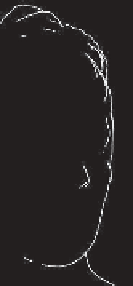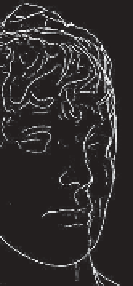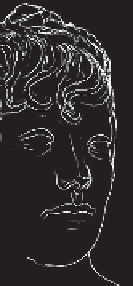Graphics Reference
In-Depth Information
Figure 34.18: Shaded view, contours, suggestive contours, ridges and valleys, and apparent
ridges for a single model. Courtesy of Tilke Judd and Frédo Durand, ©2007 ACM, Inc.
Reprinted by permission.)
the surface is wiggly enough somewhere, then that point's likely to be on a sugges-
tive contour. There is another kind of line—apparent ridges [JDA07]—that is also
view-dependent (see Figure 34.18). In this case, however, the view dependence
has an interesting character: It takes into account the projection of the surface to a
particular view plane, and performs measurements in that view plane rather than
on the surface itself. Since the projection of the object to the view plane captures
what we can
see,
measurements made in this plane correspond to operations that
our eyes could possibly perform. Thus, a slight curvature near a contour is drawn,
while the same amount of curvature in a frontal region of an object is not.
While geometric characteristics are important for determining which lines to draw,
other characteristics may matter as well, such as texture: The lines between stripes
on a plaid shirt should be drawn along with the contours of the shirt. This is essen-
tially a reversion to the computer-vision notion of
edges,
discontinuities in bright-
ness at some scale. This idea was implemented as an expressive rendering scheme
by Lee et al. [LMLH07]. They first rendered a scene with traditional shading,
and then used this preliminary rendering as a source for the final rendering. They
searched in the preliminary rendering for brightness discontinuities, which were
then rendered as lines in the final rendering, typically representing contours or tex-
ture changes like the stripes on a shirt. They also searched for thin, dark regions,
which were rendered as dark lines, and thin, light regions, which were rendered as
highlight lines (see Figure 34.19). The large-scale shading in the final rendering
was done with
two-tone shading
[LMHB00], created by thresholding the prelim-
inary image on brightness.
Figure 34.19: Abstracted shad-
ing with highlights. (Courtesy
of Seungyong Lee, ©2007 ACM,
Inc. Reprinted by permission.)
The representation of a shape by lines is a kind of abstraction. Of the three kinds of
abstraction we mentioned (simplification, factorization, and schematization) this
form of shape representation falls into the first or second category, involving the









